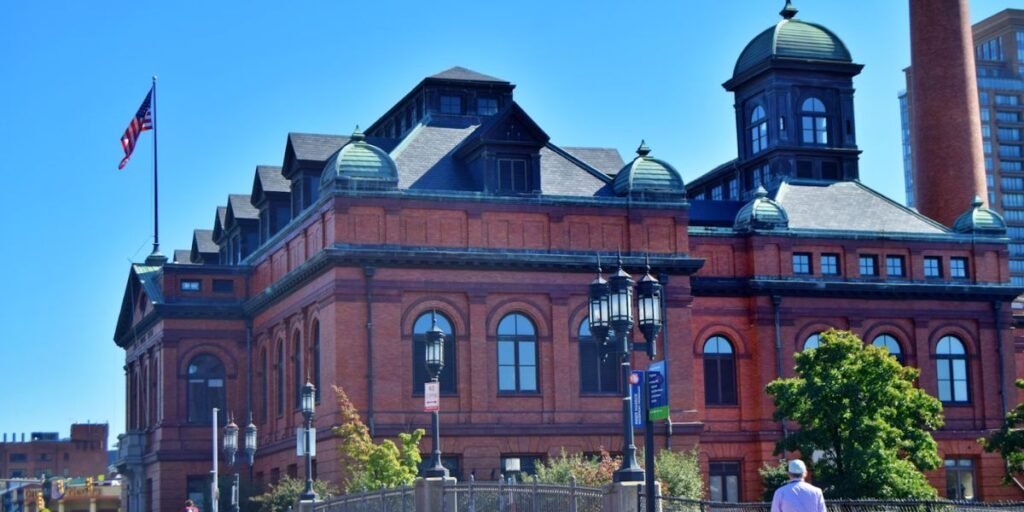Baltimore, Maryland, represents a unique ride of affordability, culture, and opportunity among cities. It is, however, very advisable to understand the city’s dynamics before you make the relocating leap. With a median home price of around $225,000, Baltimore remains more affordable than many other major East Coast cities, while rental costs average $1,550 per month.
The city’s different neighborhoods, such as Hampden and Fells Point, offer unique living experiences, but potential residents should be aware of Baltimore’s higher crime rates and variable public transportation reliability.
On the positive side, Baltimore boasts many a job opportunity in healthcare, education, and tech, making it an attractive option for professionals. Understanding these factors will help ensure a successful transition to Charm City.
Below we’ll cover some of the bread-and-butter factors of moving to Baltimore: Costs of living, the job market, education, neighborhoods, and transportation.
Costs Of Living In Baltimore, MD
Let’s start from the beginning – costs of living in Baltimore. Compared to the financial hurdles that are other East Coast cities, Baltimore can offer a relatively affordable lifestyle. Bear in mind though, that costs can indeed vary dramatically based on the neighborhood
- Housing Costs: The price for a middle-of-the-road home is situated around $175,000. This works to your benefit because this is lower than the national average. A modest apartment in the city center is about $1,400 a month. The same apartment outside the center would cost around $1,100. Federal Hill and Canton are on the pricier side, and Highlandtown and Hamilton are more budget-friendly.
- Utilities And Essentials: Utility costs in Baltimore are around the national average. Electricity, heating, cooling, water, and garbage rack up to an average monthly expense of $150 to $200. Internet service costs between $60 and $80 per month.
- Transportation: In terms of public transportation, Baltimore’s offer consists of buses, light rail, and a subway. A monthly pass covewring all modes of transportation is $75. Many residents prefer driving, with gas prices around the national average. Parking can be an additional expense, especially in densely populated neighborhoods.
- Groceries And Dining: Grocery costs stand above the national average but only slightly. $800 to $1,000 worth of grocery shopping per month is a realistic expectation for a family of four. Eating out varies widely, which is completely expected, with meals averaging $15 and mid-range three-course meals for two costing about $60.
Job Market And Employment Opportunities
Baltimore’s job market has strong sectors in healthcare, education, and technology, so we’ll cover those. Of course, this isn’t the end of all of the job market offers, but here is space for the major ones.
- Healthcare Sector: Leading hospitals like Johns Hopkins and the University of Maryland Medical Center call Baltimore their home, and this has a big impact on the city. This means there are a lot of calls for medical and administrative roles.
- Education And Research: If you have the impression that top-end jobs in Baltimore revolve around Johns Hopkins you’re not entirely wrong. Due to Johns Hopkins University and the University of Maryland, opportunities overflow in teaching, administration, and research, particularly in biomedical fields.
- Technology And Startups: The offer in these fields can’t match the ones in healthcare and education but it is growing. Fields you can expect to grow are mainly cybersecurity, biotech, and health IT. So, not too far away from Baltimore’s main focus but it helps with variety.
We would be remiss not to mention that, of course, there are many other jobs and fields available in Baltimore, but here we wanted to give a spotlight to the heavy hitters.
Education And School Systems
If your whole family with kids is moving or if you’re a young individual at the start of life, education is going to be a big concern. We’ll go over public and private schools and universities.
- Public Schools: In all honesty, this is a mixed bag. There are high-performing and underperforming public schools, so don’t miss out on doing your research for specific schools in your prospective neighborhood. Some schools, like the Baltimore School for the Arts, offer specialized programs.
- Private And Charter Schools: This comes down to how much you can afford for your child’s education. Baltimore has private schools going from $10,000 to over $30,000 annually. Regarding diversity, there is a lot to choose from, including religious and independent schools.
- Higher Education: This is where Baltimore shines. You guessed it, we’ll have to mention Johns Hopkins University again, along with Morgan State University, and the Maryland Institute College of Art (MICA). The focus is still on medical studies but other files have nothing to be ashamed of.
Neighborhoods And Lifestyle
Settling in the right neighborhood is important in any city, and it is doubly so in Baltimore since there are a lot of differences between districts.
- Historic Districts: Baltimore’s historic neighborhoods are pricey but you’ll get to enjoy cobblestone streets and great restaurants. Areas like Fells Point and Federal Hill, are the first that come to mind..
- Suburban Living: Roland Park, Hampden, and Catonsville represent suburbia – quiet streets with treelines and larger homes. If you’re moving with your family, these are the top picks.
- Artistic And Bohemian: And now for something more special. Station North and Highlandtown have an artistic vibe, with art scenes and more affordable housing options. These areas attract a diverse mix of residents, including artists and young professionals. If you’re young and want to mingle with the hipster crowd – these areas are the place to be.
- Family-Friendly Neighborhoods: If money is no object then just pick Canton or Patterson Park. The schools are great, there are a lot of parks and the community scene is very much alive
Transportation And Commuting
We’ve already mentioned transportation briefly under costs of living, but it is now time to go into it deeper..
- Public Transportation: Baltimore’s public transportation system works just fine, and, as we mentioned before, the monthly ticket for all modes of transportation is around $75. Of note, there is also the Charm City Circulator, a free shuttle service that is pretty cool
- Driving And Traffic: Traffic congestion during peak hours is something you can expect. Parking can also be a challenge in some neighborhoods both in terms of cost and space. All in all, it doesn’t look good, but that’s how it is with most big cities.
- Cycling And Walking: The situation is improving in this area since dedicated bike lanes and bike-sharing programs are being developed. Walking is also viable, but only in some neighborhoods like Fells Point and Mount Vernon.
- Air Travel: Baltimore/Washington International Thurgood Marshall Airport(BWI) is located just outside the city and offers numerous domestic and international flights. The airport is easily accessible by car, Light RailLink, and Amtrak. All in all, standard fare in this area.

Wrapping Up
By now we hope we’ve covered the basics of moving to Baltimore. To be fair, we’ve given just a general overview of what you might expect when moving to Baltimore. In all likelihood, you will need to prepare much more specific information as the date of the move approaches.
While this sounds ubiquitous, it’s always a good idea to be informed, so spare no expense in making sure you know all about the area you’re moving to.
To round this off, if you’re into a mix of great job opportunities and a vibrant cultural life don’t miss out on Baltimore.
















